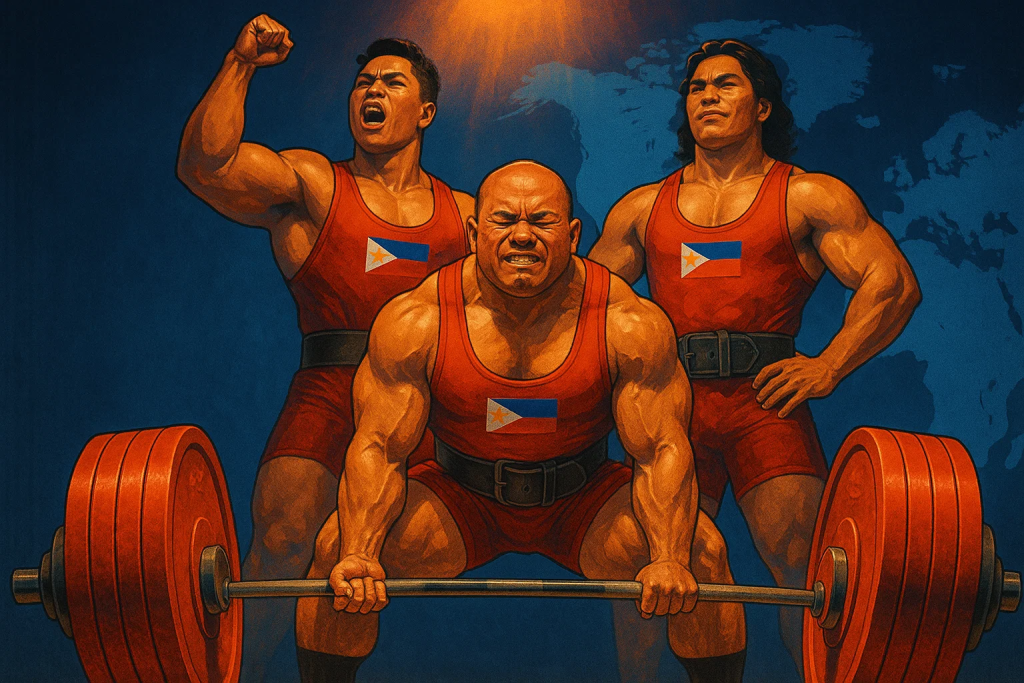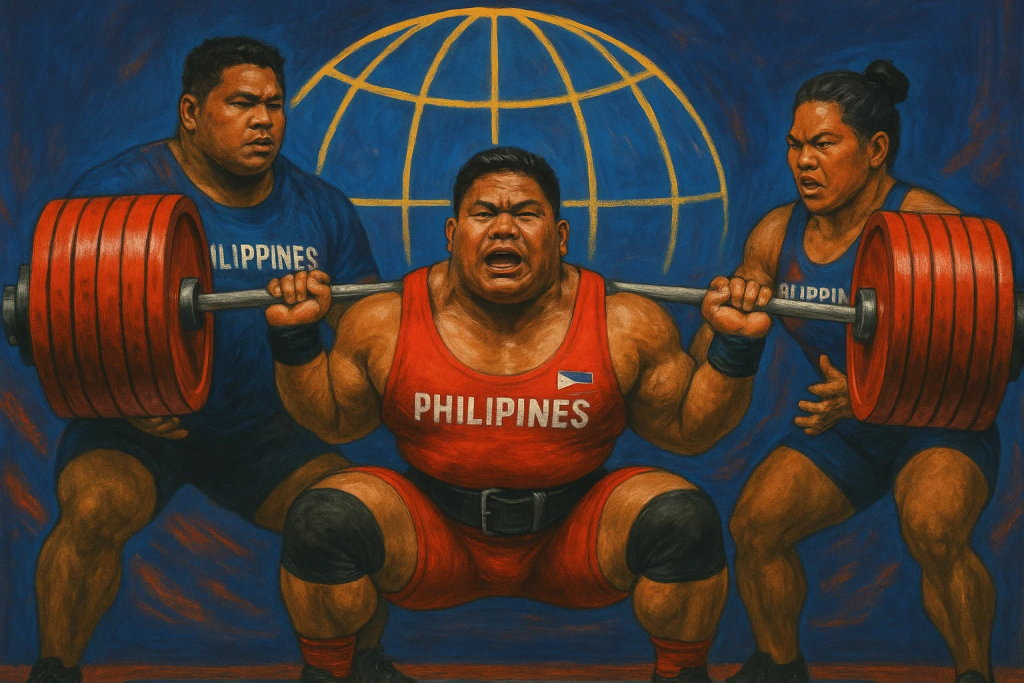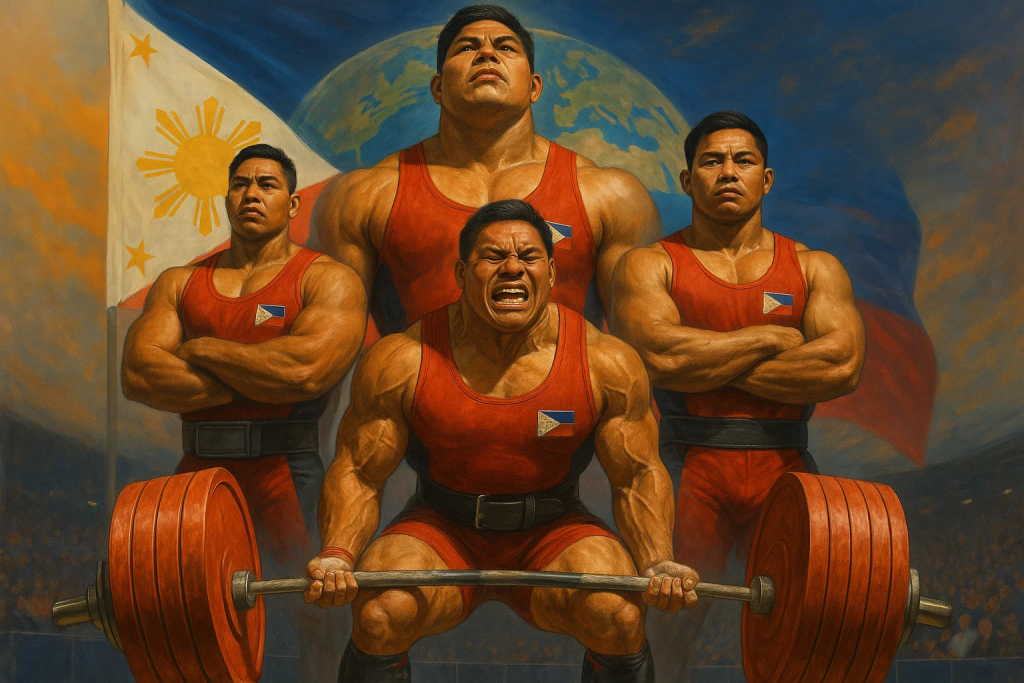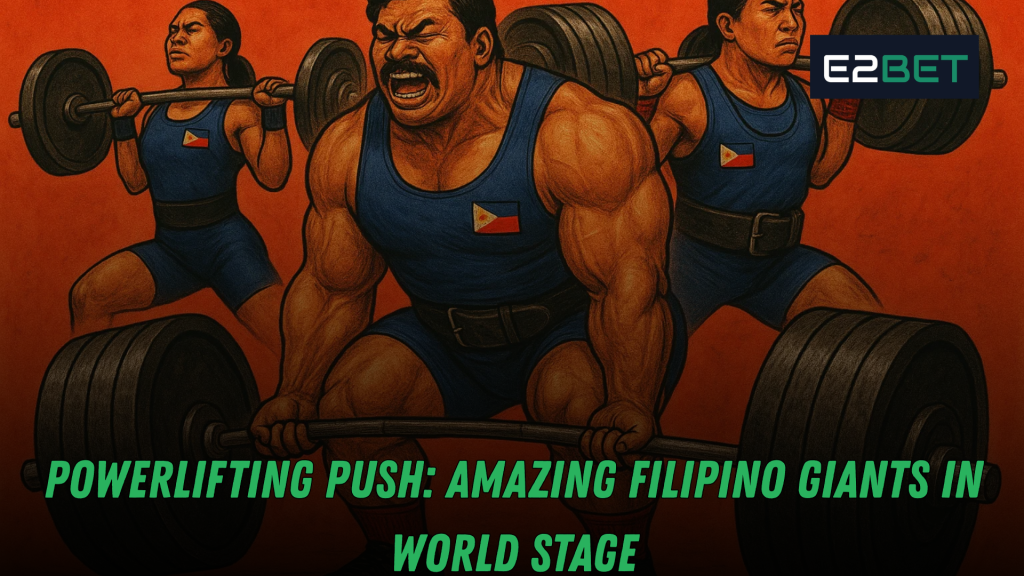Table of Contents
Introduction: Strength with a Story
Across the archipelago, strength in powerlifting is not just a performance metric; it is a narrative thread that runs through family, faith, and community. The sight of a lifter chalking their hands before a heavy attempt speaks to the country’s long tradition of grit and resilience. Filipino athletes have been pressing beyond perceived limits, showing that world-class results do not depend solely on facilities or budgets, but on a culture that prizes consistency, mentorship, and heart.

What Makes Filipino Powerlifting Different?
There is a practical humility to training across the Philippines. Many clubs share equipment; novices learn side by side with veterans; and coaches embrace a blend of modern periodization and street-smart adaptation to heat, humidity, and limited resources. The result is lifters who read the room, make smart calls on attempt selection, and lift with visible intent. The path to the world stage is paved not only by sets and reps but also by social support: families waking up at dawn to cook meals, friends …
Cultural Foundations
- Community first: Clubs function like extended families. Lifters carry each other’s plates, celebrate each other’s milestones, and share cues openly.
- Faith and gratitude: Rituals before big lifts help focus attention and reduce anxiety, turning pre-lift routines into a source of calm.
- Resourcefulness: Creative solutions—DIY deadlift platforms, repurposed bars, and heat-management strategies—build mental toughness as much as physical strength.
The Three Big Lifts, Filipino Powerlifting Style
Squat
Balance and bar path are coached patiently, often with pauses to engrain stability. Many coaches emphasize hip and torso coordination and prioritize bracing cues that are simple and repeatable, even under competition stress.
Bench Press
Filipino benches often prioritize shoulder health and sustainable volume. Arch mechanics are trained progressively; lifters learn to respect range of motion while maximizing leg drive and scapular stability.
Deadlift
Speed off the floor is a recurring theme. Pulls from blocks, floating deadlifts, and tempo negatives help lifters stay patient at mid-shin, where many attempts are won or lost. Recovery tools—breathing drills and short walks in the sun—are used to nudge the nervous system back to baseline after heavy sessions.
Roadmap to the Powerlifting World Stage
To compete internationally, athletes and coaches need more than big totals. They need paperwork done correctly, travel logistics lined up, and a stress-tested plan for weight cuts, jet lag, and unfamiliar food. The best teams treat each meet like a project with deadlines and backups: equipment checklists, opening attempts anchored to recent training data, and a contingency tree if warm-ups feel heavy.
Periodization That Works in the Tropics
- Heat-aware programming: Volume blocks often start earlier in the morning to keep perceived exertion in check.
- Microcycles with built-in flexibility: Coaches shift heavy days forward or back based on bar speed data and athlete readiness.
- Stay-ready conditioning: Short sled drags or step-ups keep heart rate variability in a healthy range without interfering with strength.
Attempt Selection Philosophy
- Openers are conservative enough to guarantee a total, yet heavy enough to set the tone.
- Second attempts consolidate the day’s plan; they aim to lock in personal records or strategic jumps for podium position.
- Third attempts respond to the scoreboard, not the ego—chasing kilos that matter for medals, teams, or qualifying standards.
Nutrition and Weight Management
Filipino cuisine offers a powerful toolbox for lifters: rice for quick glycogen, lean protein from fish and chicken, and micronutrient-dense tropical fruits. The key is structure. Lifters who pre-log meals and hydrate intentionally feel sharper on the platform. In weight-class sport, restrained strategies beat last-minute cuts. Coaches often encourage “slow-cook” recomposition: maintaining performance while improving body composition across months, not days.
Sample Competition Week Plan
- Seven days out: Final heavy singles at eight to nine RPE, then taper volume.
- Four days out: Dial in sleep, sodium, and water; confirm travel snacks.
- Meet-eve: Short primers—light squats and bench with explosive intent; a few crisp deadlift singles at submax speed.
- Meet day: Breakfast with familiar carbs, sips of electrolyte solution between warm-ups, and tiny bites after each attempt to keep blood sugar stable.
Coaching the Next Generation of Powerlifting
Great nations in strength sport grow pipelines, not just heroes. The Philippines is seeing more school-based clubs, university programs, and municipal gyms offering introductory classes. The message to parents is clear: strength training is skill training. When done correctly, it teaches posture, patience, and goal setting. With certified coaches and age-appropriate loads, youth progress safely while building confidence that carries beyond the platform.
Women Rising
Women lifters are rewriting expectations across Southeast Asia, and Filipino women are a driving force. From novice meets to elite stages, they demonstrate that technical mastery and consistency yield steady jumps in competition totals. Visibility matters: videos that show proper spotting, clear commands, and calm meet environments invite more girls to try their first session. Mentorship circles—female coaches guiding newcomers—accelerate retention and skill transfer.
Masters and Para Athletes
Strength has no age limit. Masters lifters bring valuable perspective, pacing their training with joint health in mind. Para athletes showcase a pure expression of courage and discipline, proving that adaptive equipment and thoughtful coaching can open doors to meaningful competition experiences.
Equipment: Buy Once, Cry Once
Bars, plates, belts, and shoes are investments. Filipino clubs stretch every peso by prioritizing what moves the needle:
- A calibrated set if possible: Consistency across training and competition keeps expectations aligned.
- Sturdy racks and spotter arms: Safety is a performance enhancer.
- Belts and sleeves that fit: Comfort breeds confidence.
- Chalk and fans: In hot gyms, small comforts deliver outsized returns.
Data Without the Drama
Spreadsheets and velocity trackers are helpful, but the core principles remain simple: progressive overload, technical excellence, and recovery. Coaches blend subjective feedback with objective markers—bar speed, session RPE, sleep hours—to decide whether to push or pull back. Reframing plateaus as information, not failure, keeps morale high and keeps training productive.
Media, Messaging, and National Identity
When Filipino lifters step on international platforms, they represent more than themselves. They broadcast a story of diaspora resilience, OFW families, and the quiet competence of coaches who learned by doing. Telling those stories ethically involves consent, accurate captions, and context that honors both athlete and community. The best features explain rules and commands, helping casual viewers appreciate the strategy behind attempt selection and the pressure that builds across nine lifts.
Building a Sustainable Federation Footprint
For long-term success, national systems must be boring in the best way: predictable calendars, transparent qualification standards, and clear codes of conduct. Clubs that register members, educate spotters and loaders, and run safe meets create a culture where athletes can plan their year and sponsors can plan their budgets. Good governance attracts good will.
The Volunteer Engine
Meets run on volunteers who set racks, load plates, read commands, enter data, and keep flight sheets organized. Recognizing and training this workforce reduces mistakes and keeps sessions on time. A smooth meet protects athlete focus and improves the spectator experience.

How Fil-Global Collaboration Lifts Everyone
The Filipino diaspora is a superpower. Athletes and coaches living abroad send knowledge, used equipment, and even open doors to training camps. Joint seminars—online and in person—let lifters compare technique nuances, from stance width to grip choices. Overseas meets provide pressure testing; home meets provide community. Together they form a loop that compounds year after year.
Common Mistakes and How to Fix Them
- Maxing too often: Treating every day like a test erodes progress. Instead, cap top sets and cash out volume with clean technique.
- Ignoring recovery: Sleep debt, dehydration, and skipped meals degrade bar speed long before motivation fades.
- Program hopping: Changing templates weekly prevents adaptation. Commit to cycles long enough to see trends.
- Over-tight cuts: Aggressive last-minute reductions crush performance. Favor small, steady tweaks and contingency plans.
- Comp day chaos: Without a timeline, warm-ups rush or stall. Print a schedule, assign roles, and rehearse commands.
A Training Template You Can Adapt
Goal: Build strength while protecting joints and managing heat.
- Day 1 — Squat Focus: Competition squat 4×3 @ 75–80%; paused squat 3×3; single-leg accessories; breathing drills.
- Day 2 — Bench Focus: Competition bench 5×3; incline dumbbell press; row variations; triceps extensions; rotator cuff work.
- Day 3 — Deadlift Focus: Deadlift 4×2 @ 78–83%; RDL 3×5; planks; hamstring curls; easy cyclical conditioning 10–12 minutes.
- Day 4 — Press + Hypertrophy: Close-grip bench 4×4; front squat or leg press 3×8; lateral raises; back extensions; calves.
- Optional GPP: Sled drags, step-ups, jump rope, and long walks for active recovery.
Progression: Add 2–5 kg to main lifts every one to two weeks if bar speed and form stay solid. Deload every fourth week or after a meet simulation.
The Psychology of the Platform
Nerves are normal. Filipino lifters channel pressure into presence using simple routines: a brief visualization, a breath-counted walk to the bar, and a cue or two at liftoff. Coaches stand where lifters can hear commands and see clock time. Between attempts, the team keeps chatter light and focused. Athletes who journal after meets learn faster: what worked, what to change, and how to enjoy the day more.
Sponsorships and Storytelling for Growth
Sponsors support what they understand. Clear proposals—audience demographics, event calendars, media plans—convert interest into funding. Brand-safe content shows the sport’s family-friendly side: coaches adjusting racks, athletes thanking volunteers, and fans cheering good lifts from all teams. The Philippines excels at hospitality; turning meets into community festivals creates memories that sponsors want to return to.
A Blueprint for Clubs
- Start small, iterate: One bar, a few plates, and strict safety standards beat a cluttered gym with loose rules.
- Document standards: Range of motion, rack heights, and warm-up etiquette posted on the wall help everyone move faster.
- Coach education: Host quarterly clinics. Share notes on cueing, mobility, and meet rules.
- Open doors: Beginners’ days, women’s hours, and scholarship slots invite new lifters who might become tomorrow’s champions.
Why the World Stage Matters
International competition compresses learning. Athletes discover how travel, time zones, and new referees affect rhythm. They see rival strategies up close and come home with eyes for detail. The world stage also unites the community at home—families gather around livestreams, clubs host watch parties, and young athletes learn to dream in kilos and commands.
Myth-Busting for Newcomers
- Myth: Strength sports are unsafe for teens. Reality: With qualified coaching and appropriate loads, they are among the most measurable and teachable activities for adolescents.
- Myth: You need elite gear to begin. Reality: Start with safe basics; upgrade as your technique and commitment grow.
- Myth: Small lifters cannot be competitive. Reality: Weight-class systems celebrate relative strength and reward technical precision.
The Filipino Edge: Heart and Consistency
Talk to any champion and a pattern emerges: years of ordinary days. Work before dawn. Meals packed in plastic containers. A team that notices when you are tired and reminds you why you started. That relentlessness is the quiet engine behind big meets. It is the reason totals keep inching upward through plateaus and life events.
Call to Action: Join the Movement
If you are a coach, start a basics class this month. If you are a parent, visit a local club and watch a session. If you are a lifter, register for a meet—nothing accelerates learning like nine attempts under the lights. If you are a sponsor, underwrite plates or travel for junior teams. And if you are a fan, stream the next event and share an encouraging note. Every rep, every rack, every volunteer shift moves the sport forward in the Philippines.
Rules, Standards, and Commands That Shape the Platform
At first glance the sport looks simple, yet every attempt is guided by rules that make competition fair. In powerlifting, judges look for clear depth in the squat, visible pauses on the chest for bench, and a controlled lockout on the deadlift. Athletes practice listening to commands so that their efforts translate into good lifts on the scoreboard. Newcomers often discover that learning the language of powerlifting—“start,” “rack,” “down”—is as important as adding plates. Clear standards protect…
PH Sports Funding: Govt. Boost for Amazing Grassroots Programs
Tested and Untested Pathways
Another unique feature of powerlifting is the choice between tested and untested federations. Each path has its own calendar, weigh-in rules, and equipment policies. Many Filipino teams prefer the tested route to align with school programs and public funding. Others compete untested for different challenges and travel opportunities. Whichever path athletes choose, the fundamentals of powerlifting remain the same: safe technique, steady progress, and respect for the platform.
Philippine Strength Stories: A People of Comebacks
Across cities and provinces, stories echo with determination. Lifters who once trained on borrowed bars now coach juniors. Overseas workers return home with new cues and donate gear to local gyms. These narratives matter because they show how powerlifting is more than totals; it is a vehicle for social mobility and pride. Families rally around livestreams, and barangay halls turn into viewing parties. The arc repeats: discover powerlifting, join a club, learn the lifts, and pass the torch.
From First Meet to First Medal
The first meet teaches what no video can. Athletes learn to manage time, share warm-up racks, and sign attempt cards under pressure. They also learn the joy of nine chances to write a personal script. Many fall in love with powerlifting at this stage, realizing that the community is as rewarding as the numbers. With each cycle, they refine nutrition, recovery, and travel checklists. Momentum builds, and the Philippines gains another voice on the international broadcast.

Training Science, Tropical Reality
In powerlifting, the body adapts to what it practices. Filipino coaches design cycles that respect heat and humidity. They sequence heavy exposures early in the day, sprinkle isometrics to fortify sticking points, and keep accessory work purposeful. Cooling towels, shade breaks, and mindful breathing become part of the warm-up. Rather than chase novelty, programs return to what works. The mature mind set is simple: let powerlifting be a masterclass in delayed gratification.
A 12-Week Outline for Competitive Focus
- Weeks 1–4 (Build): Rehearse commands, expand work capacity, and groove technique with submax sets. Keep powerlifting fun; celebrate small, frequent wins.
- Weeks 5–8 (Bridge): Push top sets while guarding bar speed. Use video to confirm form. Treat powerlifting accessories as skill practice, not just volume.
- Weeks 9–11 (Peak): Reduce volume and sharpen singles. Sleep and nutrition take center stage. This is where powerlifting feels both intense and strangely relaxed.
- Week 12 (Taper + Meet): Trust the plan. Pack familiar gear and snacks. On meet day, let powerlifting be simple: three lifts, three commands, one calm mind.
Digital Era, Real-World Respect
Clubs and athletes tell their story online, but the best pages educate as much as they entertain. Post captions that explain why red lights happen; share meet calendars; highlight volunteers. Remember that powerlifting lives offline first—on platforms where loaders hustle and judges watch angles. Ethical media puts athletes’ dignity first and avoids sensationalism. It also invites newcomers, reminding them that powerlifting welcomes all sizes, ages, and backgrounds.
Travel and Logistics Playbook
- Book flights that land at least a day early; the body moves better after sleep.
- Declare equipment when required; some belts and liquids trigger checks.
- Hydrate with intention on long flights; calf pumps and short walks help.
- Print backups of IDs and letters. The calm traveler lifts better, and powerlifting rewards the calm.
Looking Ahead: Building for the Next Decade
Sustainable progress means stable funding, coach education, and local meet density. The Philippines can seed regional circuits so that lifters compete more often without costly flights. A national calendar published early each year lets clubs periodize with clarity. The grand goal is simple: make powerlifting a respected pathway for youth, women, and masters across the islands.
What You Can Do Today
If this article moved you, take one concrete step. Visit a club, message a coach, sponsor a plate, or stream a meet. Share the values that make powerlifting special: courage under a loaded bar, humility after a miss, and gratitude for teammates who spot you when life gets heavy.
SEO Corner: Make Discovery Work for You
Use slugs, schema, internal links, and powerlifting captions. Write headlines highlight Filipino strength and powerlifting values without clickbait. Map keywords to intent pages: beginner guides, meet calendars, club directories, coaching profiles. Repeat powerlifting naturally in alt text and FAQs. Earn citations by publishing meet recaps and checklists. Measure conversions, not views. Encourage communities to search for powerlifting clubs near them, powerlifting coaching, powerlifting rules, and powerlifting meets. Consistent publishing shows expertise, and powerlifting stories convert readers into powerlifting lifters.
Frequently Asked Questions
1) How can beginners find a reputable club?
Look for places that teach commands, emphasize safety, and post clear standards. Ask about coach certifications and watch how they spot and load. Trial sessions should focus on technique, not testing maxes.
2) Do I need to cut weight for my first meet?
No. Compete at your current class, learn the flow, and make changes later if needed. Performance and enjoyment matter more than scale numbers at the start.
3) What is a realistic timeline to add 50 kg to my total?
For disciplined novices, six to twelve months is common, though progress varies. Consistency and sleep often beat exotic accessories.
4) How do I balance strength with cardio?
Use short, low-impact sessions two to three times weekly. Keep them far from heavy days and watch recovery markers.
5) How do I deal with meet nerves?
Practice your exact warm-up sequence, visualize commands, and bring familiar snacks. Surround yourself with a calm team and treat the day as a celebration of training.
